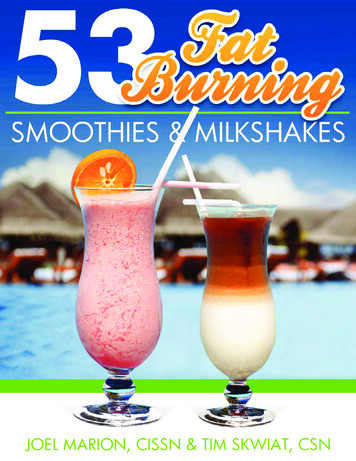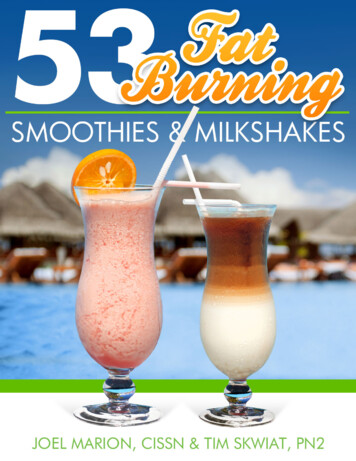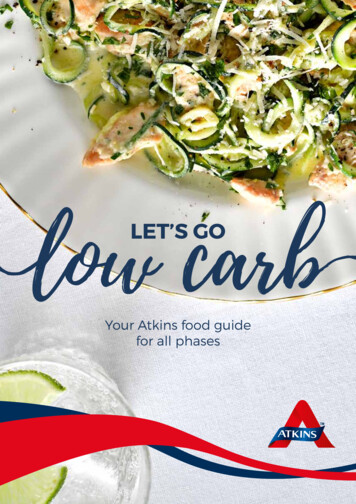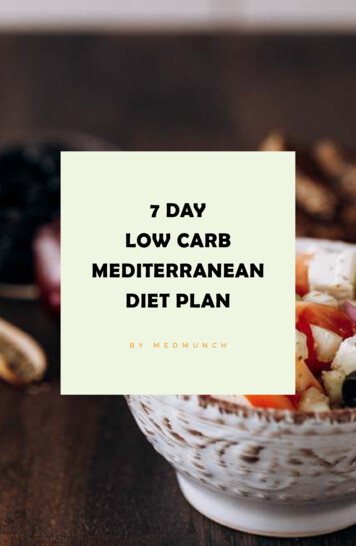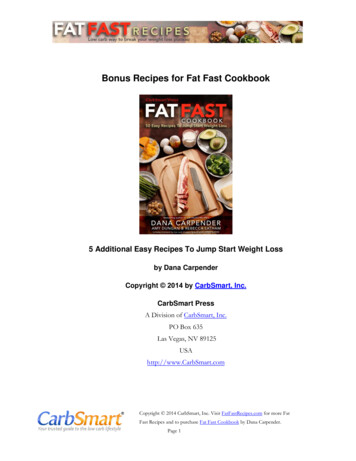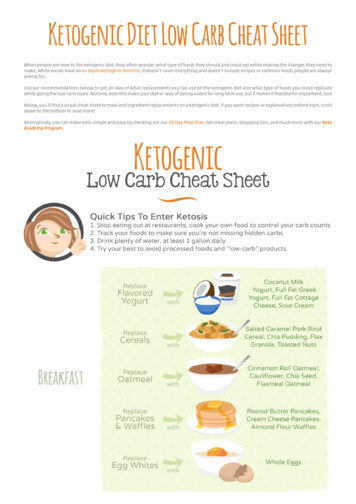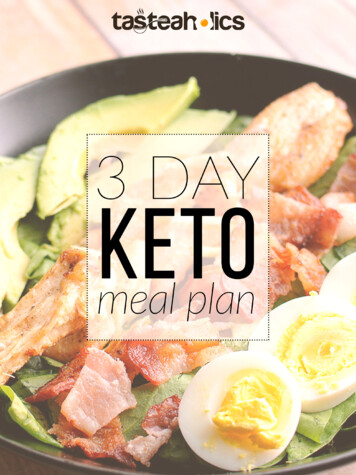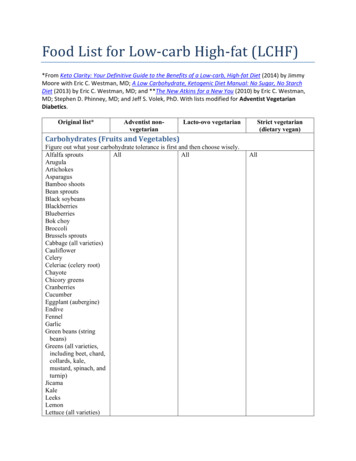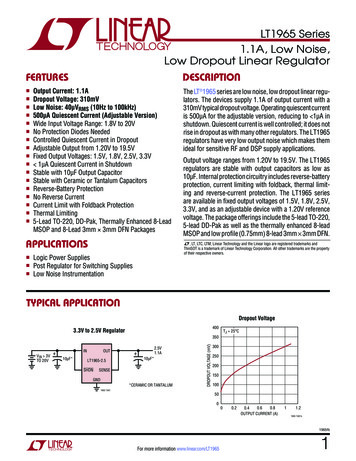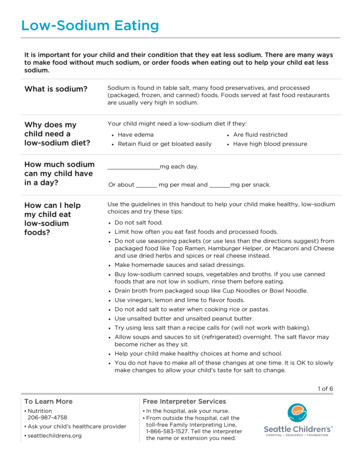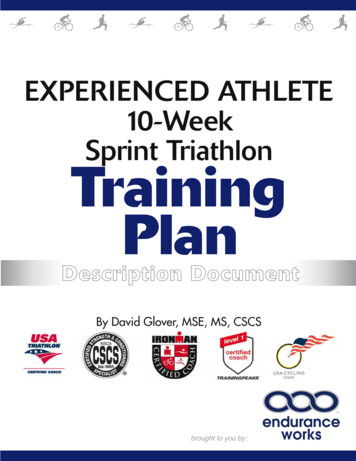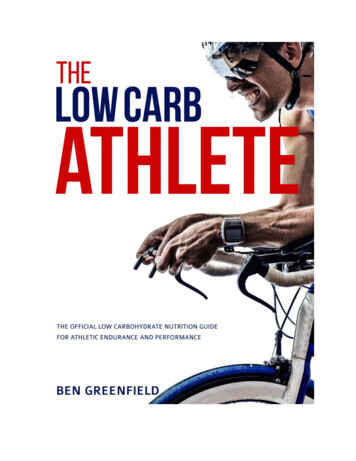
Transcription
Low-Carb AthleteThe Official Low-Carbohydrate Nutrition Guide for Enduranceand PerformanceWritten By: Ben Greenfieldwww.BenGreenfieldFitness.comPublishing Services byArchangel Ink
Copyright 2015 Ben GreenfieldThis eBook is licensed for your personal enjoyment only. This eBook may not be resoldor given away to other people. If you would like to share this book with another person,please purchase an additional copy for each recipient. If you’re reading this book anddid not purchase it, or it was not purchased for your use only, then please return toAmazon.com and purchase your own copy. Thank you for respecting the hard work ofthis author.
IntroductionI bet I know what you’re thinking.If you burn a significant number of carbohydrates during exercise (and you do), thenhow on earth can it be beneficial to consume a low-carbohydrate diet?In the first few pages of this guide, you’ll not only learn why a low-carbohydrate dietmay be the smartest nutritional change you’ll ever make in your training program, butyou’ll also find out why a high-carbohydrate diet may be hampering your performance,your health, and your longevity.Next, you’ll find out how to answer common objections your friends and trainingpartners will probably throw your way once you begin a low-carbohydrate diet, such as,“Isn’t carbohydrate and glucose necessary for energy?” and “If you replace carbohydrateby eating more fat, won’t your cholesterol increase?” and, of course, the ever popular“How the heck are you going to carbohydrate load?”Then you’ll get an overview of the low-carbohydrate diet for athletes. Specifically, you’lllearn proper carbohydrate, fat, and protein percentages (prepare to be shocked), how toincorporate carbohydrate cycling so you don’t bonk during important or long trainingsessions, and the basic foods and dietary supplements you’ll need to have sitting aroundyour kitchen or pantry.Finally, after reviewing your grocery list, we’ll launch into the meat of the diet (punintended), in which you’ll find out how to eat a low-carbohydrate diet for a regular weekof training, for a race week, and for race day (if you happen to be a triathlete,marathoner, etc.).So what qualifies me to tell you how to eat a low-carbohydrate diet?
First, and probably not too important, I am a sports nutritionist and exercisephysiologist with many years of experience coaching athletes of all levels and tweakingthe diets of everyone from elite athletes to weekend warriors.Second, and more important, I have successfully incorporated this diet into my owntraining, as well as the programs of the athletes I coach, and have found incrediblesuccess in well-being, energy, gastrointestinal function, training sessions, and race dayperformance. In other words, I’m not just spewing out a regurgitated form of the Atkinsdiet (a diet that is actually not low carb due to the high amount of proteins that getconverted into sugar), but instead giving you a nutrition plan that has been formedthrough testing, experimentation, and a lot of significant tweaks.So are you ready to defy the paradigm of how 99% of the sporting world is eating andlearn a nutritional approach that is going to revolutionize your training and your health?Let’s jump in.Ben Greenfield
Table of ContentsWhy Choose Low Carbohydrate?Low-Carbohydrate Diet OverviewGrocery Shopping ListMeal Plan for Regular Training DaysMeal Plan for the Biggest Training Day of the Week (Carb Refeed Day)Race Day8 Supplements That Help You Perform Better on a Low-Carbohydrate DietClosing ThoughtsAbout the AuthorThank You!Other Books by Ben Greenfield
Why Choose Low Carbohydrate?back to topI do not recommend a “strict” low-carbohydrate diet for everyone, and I especially donot recommend it for athletes who are in training phases for which they are undergoinglong hours of relatively high-intensity training (such as a professional Ironmantriathlete). But there are three categories of athletes who would benefit from choosing alow-carbohydrate diet:1) Athletes trying to lose weight.A key component of weight loss is tapping into storage fat (adipose tissue) forenergy. This fat access simply cannot happen if the body is constantly drawing oncarbohydrate reserves and blood glucose for energy. In a moderate- to highcarbohydrate diet, not only does the utilization of fat for energy become far lesscrucial, but the body never becomes ideally efficient at using fat.There is a growing body of evidence that a high-fat, low-carbohydrate diet causesfaster and more permanent weight loss than a low-fat diet. Furthermore, appetitesatiety and dietary satisfaction are significantly improved with a high-fat, lowcarbohydrate diet that includes moderate protein intake. You can read about thisresearch, as well as my own journey into becoming a fat-burning machine, at“Rewriting the Fat Burning Textbook: Part 1” and “Rewriting the Fat BurningTextbook: Part 2.”My own personal experience with a low-carbohydrate diet began with an offseason attempt to lose holiday fat pounds, followed by the stark realization that,contrary to my expectations and what I had been taught in traditional sportsnutrition classes, my performance and energy levels actually improved despite alower carbohydrate intake.
2) Athletes wanting to improve health and longevity.When glucose is used to create energy, a high number of free radicals areproduced. Free radicals are dangerous molecules that can damage normalcellular processes. The burning of fat for energy does not create this same cellulardamage. In an athlete who is already creating a high number of damaging freeradicals from exercise, further damage from high blood glucose levels becomes anasty one-two combo.In addition, the constantly elevated levels of circulating blood sugars that can becaused by a moderate- to high-carbohydrate diet are associated with nervedamage, small dense cholesterol particles (the culprits for heart disease), highmorbidity, bacterial infection, cancer progression, and Alzheimer’s. You can readabout this damage in detail in my article “How Much Carbohydrate, Protein andFat You Need To Stay Lean, Stay Sexy and Perform Like a Beast.”As you will learn later in this guide, simply getting your energy from non-bloodglucose-based energy sources can directly improve your quality of life and ensurethat you live longer and healthier.3) Athletes who have consistently poor performance orgastrointestinal distress while training or racing.Because of genetic predispositions (which can actually be tested via organizationssuch as DNAFit), some athletes are much more sensitive to the fluctuations inblood sugar caused by carbohydrate intake. Often, the result of this sensitivity is ashort-lived initial increase in energy levels after consumption of a sports bar,sports drink, gel, or other carbohydrate source, followed by a sharp and drasticdrop in energy levels. But the calories from fats and proteins are utilized at a farmore stable rate than carbohydrate sugar, resulting in more stable energy levels.
In addition, uncomfortable amounts of gas and bloating in athletes can be due tothe high rate of bacterial activity caused by carbohydrate fermentation in thedigestive tract. Many athletes experience an even greater degree ofgastrointestinal distress from food allergies or intolerances to commoncarbohydrate sources, particularly wheat.So who should not choose a low-carbohydrate diet?First, athletes in the heat of competition, such as during an Ironman triathlon or aSpartan Beast, will certainly need a higher carbohydrate intake during the event than isrecommended in this guide for the typical training week meal plan. But that’s why thereis also a race day plan included! In other words, even if you are eating a lowcarbohydrate diet during your actual training, you will need to introduce a “slow bleed”of carbohydrates (along with some amino acids and some fats) during longer trainingsessions or events that bring you past the point of glycogen depletion, which is typically60-90 minutes of moderate- to high-intensity exercise or 90 minutes to 2 hours of lowto moderate-intensity exercise. I discuss the reasons for this in detail in the podcastepisode “Five Simple Steps To Turning Yourself Into a Fat Burning Machine.”Next, athletes going through an extremely heavy block of training that is a higher loadthan they are accustomed to, such as a triathlon camp that involves 25-40 hours oftraining per week, will also need a higher carbohydrate intake (although this volume oftraining combined with higher carbohydrate intake is not healthy, it is a necessarysacrifice for injecting large doses of endurance into the body).Finally, individuals with diseases or conditions that disable the ability to properlymetabolize fats and proteins (such as gallbladder removal) may also need to eat a higherpercentage of daily calories from carbohydrates, since they simply cannot digest fatsvery well. Some of this can be managed with digestive enzymes that can assist with fatdigestion, but ultimately, some folks simply can’t handle extremely high amounts of fatcombined with low amounts of carbohydrate. You might think that simply adding in
more protein would be the answer, but then you begin to play with issues related toprotein toxicity.Answering ObjectionsOnce your training partners, family, or other friends learn that you’re eating fewercarbohydrates, you’re guaranteed to hear several objections and see some raisedeyebrows. Typically, the criticism of a low-carbohydrate diet falls into three categories ofquestions:Objection #1: Isn’t glucose and carbohydrate necessary for energy duringexercise?As mentioned earlier in this guide, directly burning blood glucose for fuel causesa significant amount of free radical damage compared to burning storagecarbohydrate, storage fats, or circulating fats in the bloodstream. This type of fuelutilization occurs in the endurance athlete trained to eat a gel every 20 minutesduring every single training session, or to constantly have a sports drink on theedge of the pool and a bowl of pasta waiting at home to refuel after the workout.While cells can certainly burn glucose for energy, fat is a preferred energy sourcein nearly every cell, and especially for the mitochondria, which are the energycreating organelles within most cells. Until extremely high exercise intensities areachieved (rarely the case among endurance athletes) or until the human body hasexercised for two to three hours continuously, fat is completely useable as anenergy source. Specifically, natural saturated fats, omega-3 fatty acids, andmedium chain triglycerides are extremely dense energy sources that produce veryfew damaging byproducts from their metabolic use for energy.The specific parts of the body that do need glucose on a daily basis are the brain,the nerves, special proteins called “glycoproteins” (which form compounds suchas mucus), and cells within the immune system, the gastrointestinal tract, and
the kidneys. But the total daily amount of glucose calories required by these partsof the body is about 500-700 carbohydrate calories, and not the 1500-2000carbohydrate calories consumed by most endurance athletes!Objection #2: Isn’t fat dangerous for cholesterol-related heart disease, as wellas posing an increased risk of weight gain?No. Not only does a high-fat, low-carbohydrate diet perform better for weight losscompared to a low-fat, high-carbohydrate diet, but there is no evidence that thecholesterol particles derived from fat increase the risk of heart disease–unless fatconsumption is paired with a moderate to high intake of starchy, sugarycarbohydrate sources. It is at that point that cholesterol can become oxidized andlead to risk of heart disease.The entire idea that high cholesterol causes heart disease is a flawed hypothesis,and entire books have been written on it. A very good place to start your journeyinto learning about the positive and healthy properties of fats would be thewebsite www.cholesterol-and-health.com (which is in no manner affiliated withthis guide–it is simply a helpful resource).Objection #3: Don’t you need to load with carbohydrate before a race?Once you begin eating a low-carbohydrate diet, your body will, within two weeks,become more efficient at burning fat (although it’s important to realize that ittakes up to six months before you really start to “feel good” during workouts, andone to two years before you are fully fat adapted). This means that you will needrelatively fewer carbohydrates during race week or the day before a race, sinceyour body develops an enhanced ability to conserve storage carbohydrate(glycogen) and also an increased ability to utilize fat as a fuel, both during restand on race day.
What this means is that an entire week of traditional carbohydrate loading andhigh sugar intake will not be necessary, and if your goal is weight loss, health, orlongevity, it may actually end up doing more harm than good. Since I have shiftedto a lower carbohydrate intake, I have found that the 85-90% carbohydrate diet Iwas eating during race week is no longer necessary. The primary changes I nowmake during race week are A) a carbohydrate-dense breakfast the day before andthe morning of the race; and B) more frequent snacking in the last several daysleading up to the race (not allowing a feeling of hunger to set in); C) a few extracarbohydrates with dinner (such as 200-300 calories of extra carbs) from asource such as sweet potatoes, yams, or white rice. Sure, this would still beconsidered “carbohydrate loading,” but not in the common tradition of loading,which typically includes 7-10 days of high carbohydrate intake before an event,with a gradual increase of carbs up to 90% carb intake the day before a race!
Low-Carbohydrate Diet Overviewback to topThe average athlete, based on current recommendations by most personal trainers,coaches, sports nutritionists, books, magazines, etc. eats a diet of about 50-60% carbohydrate, 20-30% protein, and 20-30% fat. The major problem with this type ofdietary intake is not primarily the percentages of carbs, proteins, and fats (unless youare indeed trying to eat a low-carbohydrate diet), but instead the source from whichmany of these foods are commonly derived—cookies, crackers, pasta, biscotti, scones,bagels, muffins, energy bars, juice, processed trail mixes, etc. Each of these foods andothers like them are very high in vegetable oils, inflammatory omega-6 fatty acids,preservatives, processed ingredients, potential food allergens, refined sugars and,perhaps most annoyingly to the majority of athletes, highly fermentable carbohydratesthat cause gas, bloating, and constipation.The low-carbohydrate diet for athletes that you’re going to find in this book addressesall these issues, and includes the following components:Higher Fat Percentage: With a macronutrient percentage of closer to 50-60%fat, 20-30% carbohydrate, and 20-30% protein, the low-carbohydrate diet notonly naturally eliminates many of the unhealthy food ingredients present in ahigher-carbohydrate diet, but also introduces more stable energy levels, lessinflammation, and better weight loss. While very low carbohydrate percentagesthat you’d find on a strict ketogenic diet (5-10% carbs) will not sustain heavybouts of high-intensity exercise or voluminous training, the slightly higherpercentage of carbohydrates you’ll find in this diet are perfect for lasting health,longevity, weight loss, or elimination of digestive issues from food intolerances.Yes, you read right. The percentages listed above are not what you’ll find in astrict “ketogenic” diet. Strict ketogenesis can be difficult and uncomfortable formost and is not extremely practical from a social eating perspective, either. For
a ketogenic diet, you’d be closer to 80-85% fat, 10-15% protein, and 5-10%carbohydrate. However, by saving the majority of your day’s carbohydrateintake for the end of the day, and preferably consuming them in a post-exercisescenario anywhere from one to three hours after your workout, you will indeedbe in a state of ketosis the entire day leading up to that carbohydrate “feeding.”Many nutritionists refer to this practice as “cyclic ketosis” or a “cycling low-carbdiet.”Carbohydrate Cycling: If long-term carbohydrate deprivation and depletion ofstorage carbohydrate levels are accompanied by frequent bouts of training, thenyour immune system can eventually become depressed, physical performanceand mood can decline, and risk of overtraining can increase. For this reason,storage carbohydrate should be “reloaded” once per week, preferably on a highervolume training day during which the increased carbohydrate intake will be lessdamaging to the body. This is a practice that can be combined with the “cycliclow-carb” approach described earlier. The meal plan you’ll find in this guide is asix-day, low-carbohydrate diet with one day of moderate to high carbohydrateintake, and that higher-carbohydrate-intake day should preferably be the hardesttraining day of the week (which is typically a Saturday or Sunday for mostathletes). It’s very important to note that if you aren’t the type of exerciser orathlete who has a very high-volume training day of the week, this extracarbohydrate “refeed” day will probably not be necessary for you, especially ifyou’re already doing the cyclic low-carb approach with miniature carb refeedsat the end of each day. But if you really find yourself frequently “running intothe wall,” you’ll definitely want to include this day.Fasted Sessions: If your goal is weight loss, then more-rapid fat burningresults can be attained by including fasted morning exercise sessions in yourprogram. To implement these, simply wake up in the morning and engage in 2060 minutes of exercise before eating anything (coffee is fine). It is preferable thatthe exercise be an easy aerobic session, since hard training sessions are moredifficult to do on an empty stomach and may result in “junk” training,
overtraining, or simply too much stress early in the day. Usually, an easy swim,easy bike ride, yoga session, or even a walk with the dog is sufficient (and themore sunshine, the better, as it helps to jumpstart your circadian rhythm andnormalize your sleep patterns). Ideally, this session should be done at some pointduring a twelve-hour fast (e.g., you stop eating at 8pm the night before, thenwake up and get your easy exercise session in at 7am, then eat breakfast anytimeat 8am or after). If exercising in a fasted state in the morning is not possible foryou, then it would be preferable to include a longer fasted session, in whichdinner is completed 3-4 hours prior to bedtime, and then breakfast is eaten 1-2hours after waking, which, with 7-8 hours of sleep, can result in a 12 hour fast.You do not need to include fasted workout sessions or fasts every day of the week,but you absolutely can, and there’s no risk of “starvation mode” or metabolicdamage as long as you’re actually eating sufficient calories the rest of the day. Ipersonally include these sessions six to seven times per week. Finally, forathletes, this morning exercise session will probably not be your “main” trainingsession of the day. Your main, hard, intense or voluminous training shouldactually be later in the day, before dinner, when your post-workout proteinsynthesis, body temperature, and reaction time peaks, and before a meal whenyou’ll ideally be eating the majority of your day’s carbohydrates.Carbohydrate Intake During Long Workouts: This is where things getinteresting because there are two options:Option 1: Some people like to “train low, race high” with respect tocarbohydrates. This is what I personally did for several years. It means Itrained with a low-carbohydrate diet most of the time but used a largenumber of carbohydrates during the actual race.If you use this approach, your gut needs to be trained to absorb as manycalories as it will be taking in on race day. So if you are, say, a Half-Ironmanor Ironman endurance athlete, about once every two weeks, one of your longworkouts (typically the bike or run) will need to be accompanied by the use of
gels, sports drinks, bars, or other carbohydrate sources that you plan onusing during the race. This is basically “training your gut.” You don’t need todo this very frequently, but just enough to allow you to become used to thenutrition plan you will be implementing during race day. Although volumewill vary significantly depending on one’s size and training status, calorieintake for these carbohydrate-fueled long workouts for males will be 300-450calories per hour on the bike and 200-300 calories per hour on the run, andfor females will be 250-400 calories per hour on the bike and 150-250calories per hour on the run. All your other long workouts can be minimallyfueled, with a half to a quarter as many calories as you plan on consuming onrace day, and you do not need to fuel at all during any workouts that are anhour or less. This practice of “minimally” training your gut to digest higheramounts of carbohydrates will help you to become fat adapted, and is muchdifferent than the typical practice that athletes implement of fueling everytraining session as though it were a race.Option 2: Train low, race low. This approach involves minimumcarbohydrate utilization during training (similar to option 1) but alsoincludes minimal carbohydrate utilization during the actual event. Theadvantage is that this is a good solution if you’re eating low carb for healthreasons, or you have lots of difficulty with “energy highs and lows” fromtypical sports gels and drinks, or you have lots of stomach distress from allthose fermentable simple carbohydrates in typical sports gels and drinks, oryou want all the cognitive enhancement, focus, and superior long-termenergy that can come from competing in a state of “ketosis.”The disadvantage is that it can be hard to push yourself really hard if you’renot taking in many carbohydrates during an event that is both voluminousand intense, and for someone who is, for example, attempting to do a HalfIronman in five hours or less or an Ironman in ten hours or less, the intensityis high enough so that “racing low carbohydrate” may not be realistic. Youwould actually have to experiment during longer race simulation training
sessions to see if this approach works for you. What I’ve found is that if youcut your “normal” carb intake in half (e.g., cut from 400 calories of carbs/hrdown to, say, 200 calories of carbs/hr), then fill in those calorie “holes” withA) about 10g of amino acids per hour and B) 50–100 calories of MCT orcoconut oil per hour, then you can generally sustain long, intense efforts justfine. But you must, must, must try this in your training before you do it in arace.However, if you’re staying purely aerobic during your race and not“redlining,” then a low- to no-carb approach can work. It’s simple, really.Here’s what you do:Thirty to sixty minutes prior to the race: 1g sodium (i.e., a chicken bouilloncube—this keeps your blood pressure high enough on a low carb intake), 510g BCAAs or EAAs (branched chain amino acids or essential amino acids—and the latter are far more complete and superior) and 2-3 tablespoonsmedium chain triglyceride oil or coconut oil.Every hour during event: 5-10g amino acids (e.g., the EAA’s mentionedabove) and 100-150 calories of a slow-release starch such as UCANSuperStarch per hour. Also (optional, and discussed more in thesupplementary chapter at the end of this book), is the product “VESPA,” aunique wasp-based amino acid product that allows you to tap into your ownfat as a fuel more readily. If you find that UCAN “ferments” or doesn’t sit wellwith you, a couple other products I like are “Infinit-E” by Millennium Sports(use 50% discount code MSTBG09) and “ISKIATE Endurance” by NaturalForce (use 10% code BEN10)Basic Food Overview: Since you’ll be eating a high percentage of fats, yourkitchen will be stocked with full-fat coconut milk, coconut oil, coconut shavings,avocados, olives, extra virgin olive oil, macadamia nuts, pumpkin seeds, walnuts,sardines, salmon, cheese, heavy cream, whole fat yogurt, and fatty cuts of beef.
For added protein, you’ll also have eggs and chicken. Carbohydrate sources willbe clean-burning, easily digested fuels, including sweet potato, yam, white rice,quinoa, amaranth, millet, and fruit. Liberal consumption of non-starchyvegetables is also included. For a whole list of other healthy pantry foods to havearound for your diet, read this helpful article about my own pantry.Supplements: Your supplementation protocol is going to widely vary, andalthough the best supplementation protocol should be based on blood testing thatidentifies your specific needs and deficiencies, you should at least include threebasic foundation supplements that are highly beneficial for health andperformance in the absence of a moderate to high carbohydrate intake: a highquality multivitamin, a daily electrolyte supplement and an omega-3 fatty acidsource such as fish oil or spirulina (for the latter, I like a product called“EnergyBits,” an organic, vegan-friendly spirulina source—use 10% discount codeBEN here). For added digestive support when switching to high fat intake, youmay want to include a digestive enzyme prior to your higher fat meals. Then, foradded performance and recovery (again, not necessary, but an option if you want“better living through science”), you can include a workout and injury recoverysupplement that contains natural anti-inflammatories and some kind ofadaptogenic herb complex to assist with hormonal balance. I realize that I’vereally skimmed over many of these items, but there is more on supplementationin the chapter on supplements at the end of this book.The next several pages will introduce you to grocery shopping, then your meal plan for aregular week of training, a fueling plan for long workouts, a race week meal plan, and arace day meal plan.Please be warned that as you make the transition to a low-carbohydrate diet, you will gothrough a period of “ketoadaptation,” during which your body becomes accustomed toburning fatty acids as a primary fuel. Depending on how high your carbohydrate intakewas prior to embarking upon this low-carbohydrate dietary approach, you will go
through a period of low energy, fatigue, grumpiness, and subpar workout performancethat will last for anywhere from four days to two weeks.This drop in energy is completely normal and will subside after at least two weeks.Consider yourself warned, and as you have probably guessed, you should not switch tothis diet if you are two weeks or less away from an important race or competition.Many people find that drinking more good, clean water, along with adding a few extraservings of electrolytes, trace minerals and sea salt per day can help tremendously withthis low energy, since part of the feeling of dizziness and malaise can be due to a drop inblood pressure as your body sheds carbohydrates and water.
Grocery Shopping Listback to topFor many of the pantry-based and packaged items, I’d highly recommend you use aservice called “Thrive Market,” which is like Amazon mixed with Whole Foods!Carbohydrate Sources: Sweet potato and/or yam (these are considered starchy vegetables) White rice, wild rice, and/or quinoa Gluten-free bread or wrap Organic fruit (you can choose your favorites, but good ones are raspberries,papaya, banana, strawberries, peaches) Organic vegetables: Cabbage Butter lettuce leaves Spinach Kale, bok choy, and/or Swiss chard Broccoli Cauliflower Brussels sprouts Bell peppers Nori (seaweed) Sauerkraut Garlic Cucumber Crimini mushrooms Red onions Green onions Parsley
Zucchini Shallots Sugar snap peas Cilantro Bean sproutsProtein Sources: Wild Atlantic salmon Sardines Herring Anchovies Cod Shrimp Organic grass-fed beef (choose fattier cuts) Organic free-range chicken Omega-3 enriched eggs from free-range chickens Some kind of organic organ meat (I prefer liver from USWellnessMeats)Fat Sources (in addition to proteins listed above): Macadamia nuts Brazil nuts Almonds Pumpkin seeds Walnuts Hemp seeds Sesame seeds Chia seeds Avocados Olives Coconut oil
Whole full-fat coconut milk Unsweetened coconut shavings Whole Greek yogurt Feta or goat cheeseBeverages: Coconut water kefir Kombucha Teeccino Mineral-rich sparkling water such as San Pellegrino, Perrier, or Gerolsteiner Bone BrothCondiments: Ghee (clarified butter) if you can get it at the grocery store Lemon juice Extra virgin olive oil Apple cider vinegar Rice vinegar Sesame oil Non-soy soy sauce alternative (such as coconut aminos) Minced garlic Capers Lemon Water chestnuts Ginger Cayenne pepper Fish sauce Wasabi
Additional Recommendations:LivingFuel SuperGreens Meal Replacement. If you must get quicknutrition and don’t have time to cook, two to three heaping scoops of the LivingFuel SuperGreens mixed in ½ cup full-fat coconut milk or water can be used as ameal replacement for ANY of the meals on this plan. For an even lowercarbohydrate option, such as when you are sitting at the office or late at night, thesame substitution can be made, but with Living Fuel SuperProtein.
Meal Plan for Regular Training Daysback to topThis is the meal plan that you will stick to for six days of each week (remember thatthere is still one day per week that will involve a higher carbohydrate intake). For eachmeal, choose one option. If you are a male or a large person, choose the higher range ofcaloric volume (i.e., if it says two to three eggs, eat three, or if it says one medium-largesweet potato, choose large).Breakfast (choose 1): Whenever possible, complete any of your easy workouts in themorning before breakfast. For added benefit, do not eat within two hours of bedtime. Egg
No. Not only does a high-fat, low-carbohydrate diet perform better for weight loss compared to a low-fat, high-carbohydrate diet, but there is no evidence that the cholesterol particles derived from fat increase the risk of heart disease–unless fat consumption is paired with a moderate to high
